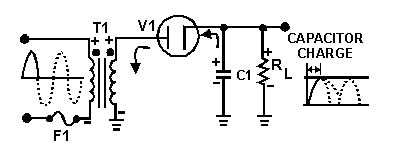3-19
Figure 3-23.—Half-wave rectifier capacitor filter (positive input cycle).
When the circuit is energized, the diode conducts on the positive half cycle and current flows
through the circuit allowing C1 to charge. C1 will charge to approximately the peak value of the input
voltage. The charge is less than the peak value because of the voltage drop across diode V1. The charge
on C1 is indicated by the heavy, solid line on the waveform.
As illustrated in figure 3-24, the diode (V1) cannot conduct on the negative half cycle because the
plate of V1 is negative in respect to the cathode. During this interval, C1 discharges through load
resistance RL. The discharge of C1 produces the downward slope indicated by the solid line on the
waveform in the figure.
Figure 3-24.—Half-wave rectifier capacitor filter (negative input cycle).
During the discharge period, in contrast to the abrupt fall of the applied ac voltage from peak value
to zero, the voltage across C1 (and thus across RL) gradually decreases until the time of the next half cycle
of rectifier operation. Keep in mind that for good filtering, the filter capacitor should charge as fast as
possible and discharge as little as possible.
Since practical values of C1 and RL ensure a more or less gradual decrease of the discharge voltage,
a substantial charge remains on the capacitor at the time of the next half cycle of operation. As a result, no
current can flow through the diode until the rising ac input voltage at the plate of the diode exceeds the
voltage of the charge remaining on C1. The charge on C1 is the cathode potential of the diode. When the
potential on the plate exceeds the potential on the cathode (the charge on C1), the diode again conducts,
and C1 commences to charge to approximately the peak value of the applied voltage.
After the capacitor has charged to its peak value, it begins to discharge. Since the fall of the ac input
voltage on the plate is considerably more rapid than the decrease on the capacitor voltage, the cathode
quickly becomes more positive than the plate, and the diode ceases to conduct.



